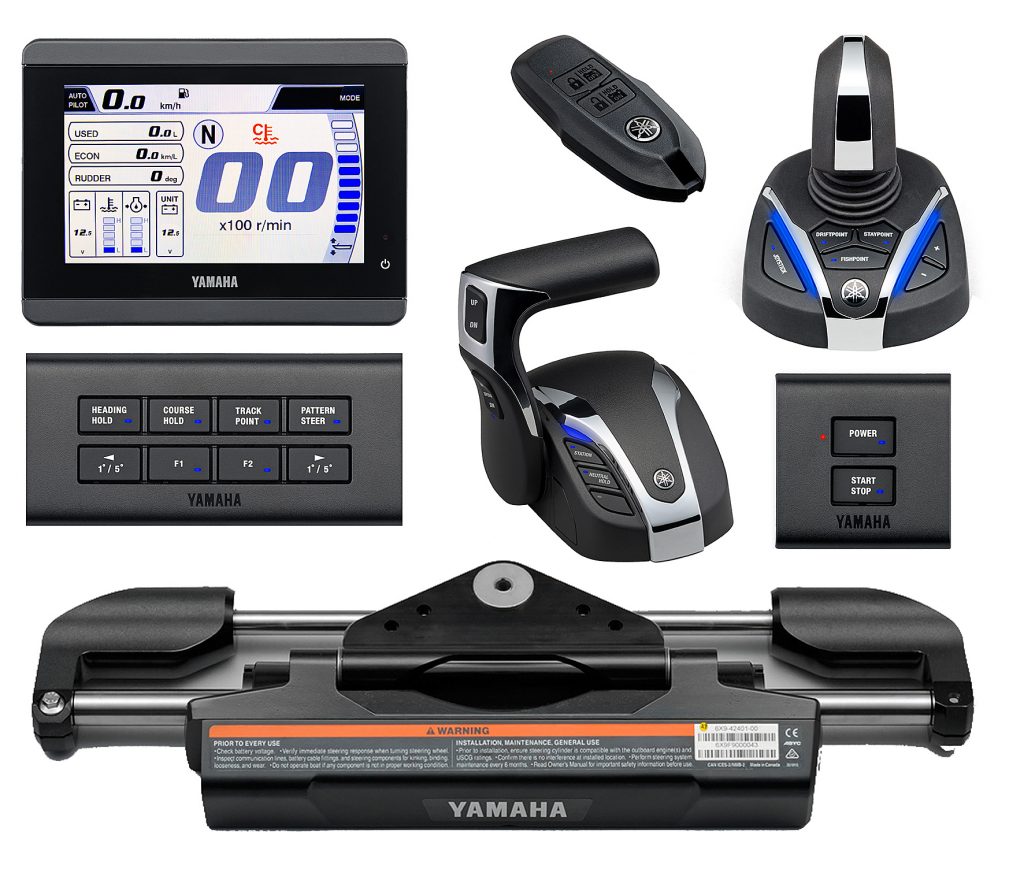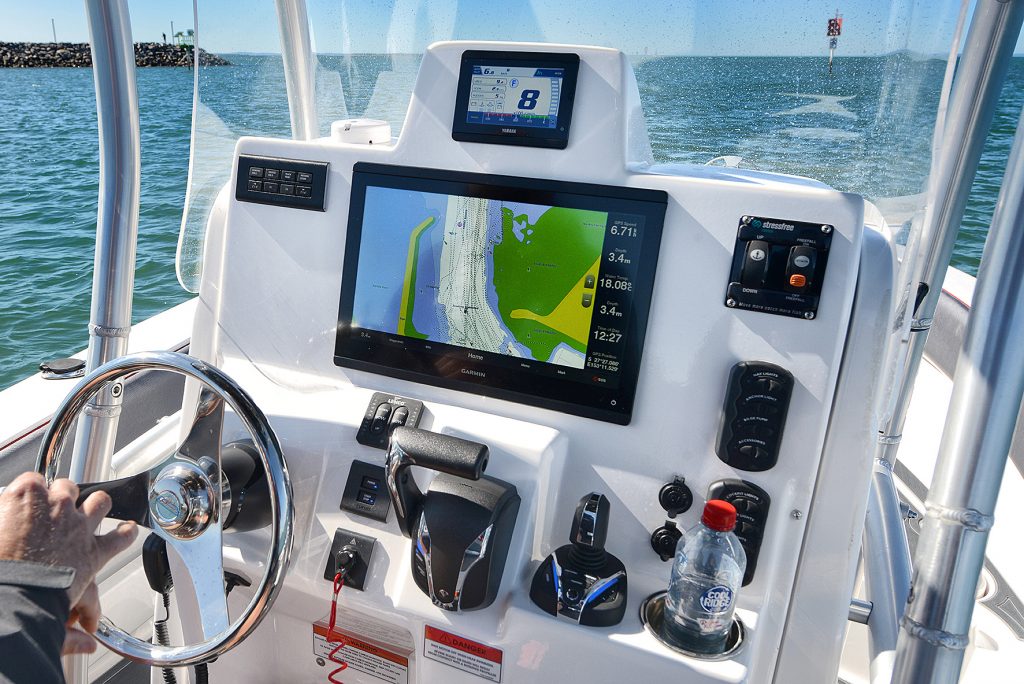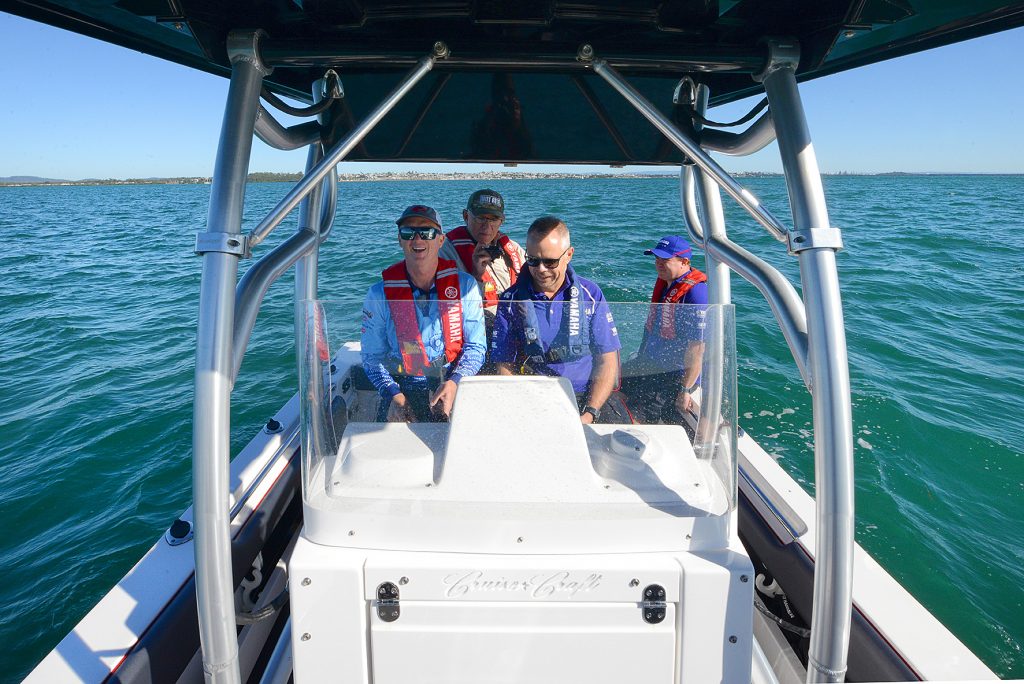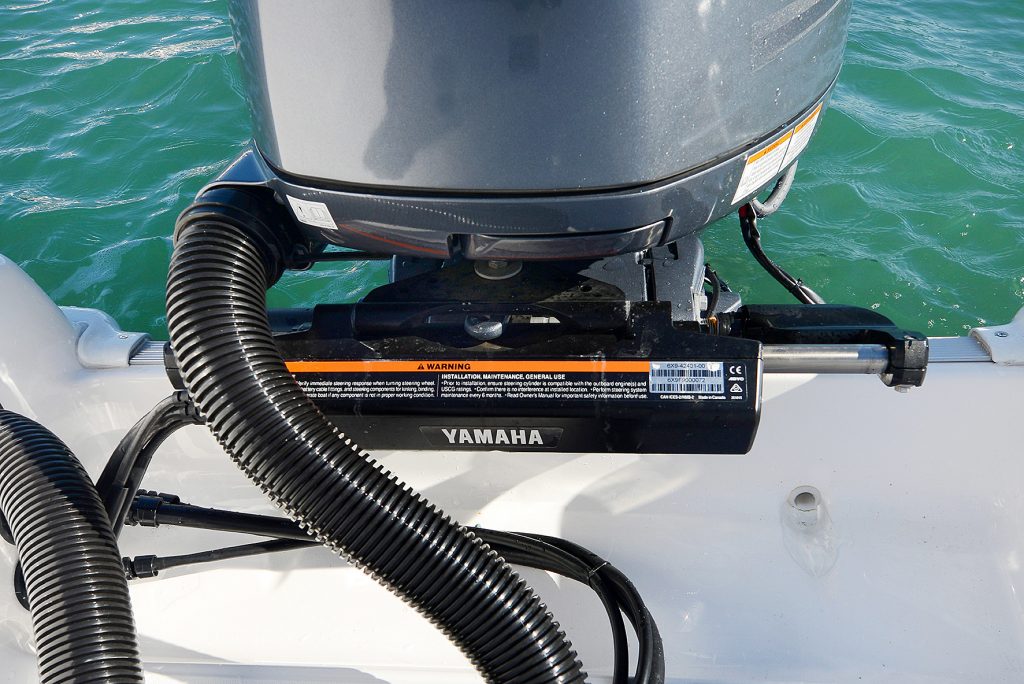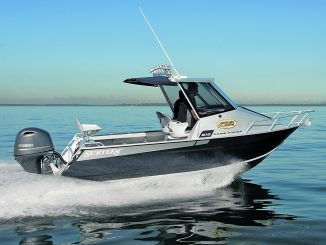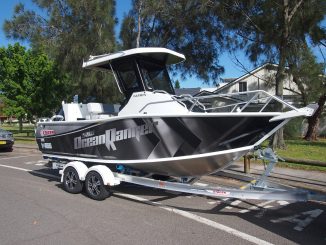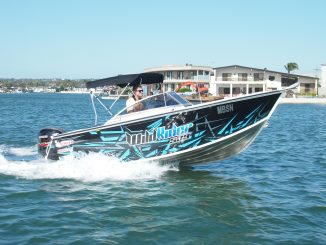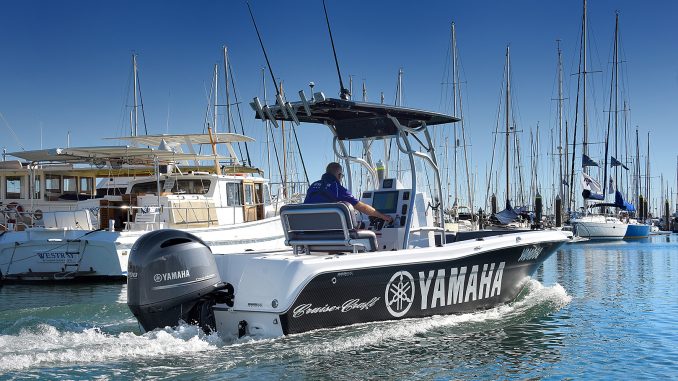
There’s not that many press days where you’re required to do your homework before you go. Normally the process is turn up, have a go of the new product and convey some impressions.
Not Yamaha’s new Helm Master EX. It’s an extension of Yamaha’s Helm Master system – a joystick that ultimately lets you drive, hold and manoeuvre a multi engine rig into whatever position or direction you like.
Helm Master uses the independence of each outboard in a twin to multi rig setup and some complicated maths to make the boat do whatever you want with a joystick to control it. Joystick is awesome.
First up, the ‘EX’ tag stands for expandable and this gives a hint about the modular nature of the new system. There’s plenty of components to it.
Hence the homework.
If you’re not up to speed with the basics, you have less time to try the product out. After all, you can read all you like from the manufacturing company, but you need to get an angler behind the wheel to get a real feel for whether the tech will make your life easier and help you to catch more fish.
So it was with great pride that Yamaha globally launched the Helm Master EX system in Brisbane, right in the middle of a global COVID pandemic. And perhaps it was fitting that the excitement around this system was contagious.
There’s a great live video from the global launch that you can find on Yamaha’s Facebook page (search July 1, 2020 on Yamaha Outboards Australia) that tells the story beautifully. Or you can read on and hear it from someone independent.
On the media day, Yamaha’s Stuart Smith proudly announced that we were about to experience a world-first. A joystick controlled single engine digital control and steering system that chucked out all hydraulics and added a proprietary autopilot, brand new touchscreen gauge and electronic key switch for good measure.
Sounds like a lot to take in? It is. Let’s break down the Helm Master EX into its components and how you can adopt a basic build right through to the complete package that’ll turn as many heads on the water as your slick Yamaha powered rig will do at the ramp.
THE BASICS
The Helm Master EX system is compatible with Yamaha Digital Electronic Control (DEC) outboards from 150hp upwards. So if your current Yamaha isn’t fly-by-wire and/or is less than 150hp, it won’t work. And it’s not compatible with any other brands of outboards.
Conversely, if you have between one and four digitally controlled Yamaha outboards, then you can start building your system.
Yamaha market Helm Master EX at four distinct levels, reflecting the basics of the system through to the tick-every-box setup.
And let’s address the elephant in the room right away – price. Feedback from the launch and associated videos showed a broad spectrum when it came to the perceived value. If you were to simplify it into memes, they ranged from “take my money” to “fainted on the floor”.
Level one of the system will set you back $9,454.61 while for the whole kit (Level 4) you’ll need $18,802.74 of space on your credit card.
Remember, though, if you’re setting up a new boat with the gear, you can delete plenty of options to offset lots of this cost; hydraulic steering, DEC or cable pre-rigging, digital screens, autopilots and even bow mounted electric motors and their associated battery setups can potentially be removed from a quote. Repowering, however, leaves you less to offset.
Food for thought, especially since there may be fewer rigging costs associated with the plug-and-play nature of the system. There’s nothing to bleed or calibrate.
LEVEL ONE: THROTTLE, SHIFT AND GAUGE
With your digital controlled Yammy strapped on the back, Level 1 of EX involves a Digital Electronic Control box, a new CL5 touchscreen display and an (optional) electronic key switch and keyless ignition.
This part of the system CAN work with a hydraulic steering setup and your current DEC Yamaha outboard.
The DEC does simple things, like allowing you to adjust the friction of the stick and control multiple outboards from a single lever if you have that sort of setup. You can micro-adjust the speed with the press of a button and you can also insulate the boat from accidental activation of the outboard by pressing a button that keeps the outboard in neutral.
More complicated features, such as Yamaha’s Trim Assist (that automatically trims the engine to the optimal height) are built into this control.
Likewise, trollers will love Yamaha’s Pattern Shift mode, which lets you control troll speed to levels LOWER than idle rpm. This feature slips the engine in and out of gear to achieve the speed that you set. Pretty handy for dealing with situations where the wind blows you too fast on the troll in one direction and you have to punch into it when you turn around.
I know I’d rather be doing other things than riding the throttle and shift all day to get this done.
Of course, you’re able to easily switch between controls if there’s more than one place on your boat you have them, a flybridge for example.
If the DEC is the engine room of the EX system, the CL5 is the customer service department. It’s a new, touchscreen gauge that’s intuitive to use and is the hub of all operations, from basic tasks such as activating the Trim Assist and setting Pattern Shift speeds, right up to more complicated functions that are activated through higher levels of the EX system.
We’ll investigate some of these now.
LEVEL TWO: DIGITAL ELECTRIC STEERING
Level two of the EX system is perhaps the most noteworthy, even if it’s the least obvious of the EX system. Yamaha’s Digital Electric Steering (DES) looks pretty similar to a standard hydraulic steering system from a distance. It’s when you get closer and see (and hear) it in action that you notice it only looks the same.
The brochure claims that there’s zero lag time between the digital helm and the DES and on the test day, these claims seemed genuine. The unit hummed away and performed flawlessly and, even though you could be mistaken for thinking that there were a couple of hydraulic lines routed to the unit, we were assured that they contained nothing more than power and data.
At the other end, a digital helm presented us with a unique steering experience. It definitely reminded me of power steering in a car and of other brand of outboards featuring similar features. The difference, of course, was that there’s not a single drop of hydraulic liquid making it work.
Additionally, the helm can be adjusted with different levels of steering friction selectable as well as the number of turns from lock to lock.
We’re sure that dealers and OEM fitters will appreciate the simplicity of fit-up with all of the DES system. There’s nothing hidden under the transom or console – just wires to plug and play. It lets you fill this space with other toys for your rig.
Importantly, Smith pointed out that when the steering isn’t moving, it’s not drawing power and makes no noise at all.
“You definitely don’t have to worry about this system draining your battery. It only draws power on demand as it’s turning the engine,” he said. This means that your standard cranking battery is all you need to run the system.
LEVEL 3: AUTOPILOT
This one is pretty big for Yamaha. It’s their own, proprietary autopilot. Seamlessly connecting into the Helm Master network, the unit’s flush-mounted 8-button simplicity reflects the ease of use of this piece of kit.
The autopilot consists of more than the console-mounted controls. There’s a heading sensor that is fitted under the console and a GPS antenna that can mount anywhere that has line of sight to the sky.
Like many autopilots, the unit lets you hold a compass bearing or alternatively navigate to a GPS point or route (when linked to a compatible multi function display (MFD). It’s clever enough to slow you down as you approach a destination waypoint and will even help you search for new ground when you’re exploring a new area.
Pattern Steer is pretty cool. You can set the craft to navigate an ever-increasing circle pattern, or to zig-zag across a reef, and while you’re doing it you can adjust the speed with the control or even engage Pattern Shift. Think sounding for new reef or trolling a search pattern for pelagics.
While holding a heading, you can tweak your course to port or starboard with the press (or multiple presses) of a button on the console pad and even inexperienced autopilot users like me could pick up the basics in no time flat.
You can set the sensitivity on the joystick (if equipped) and control any erratic actions that you may have experienced in other autopilots. You can even use Autopilot with Pattern Shift to the full, hands-free, slow-trolling experience.
With the incremental build, we’re naturally headed to the denouement, which is the full manoeuvrability joystick control system. We’ll just call it a joystick in the next section.
To enable the joystick, you do need to have all three lower levels of the EX system installed.
LEVEL 4: THE STICK OF JOY
We’re not sure if Yamaha is clever or cunning, but for anglers, the real advantages of the Helm Master EX system – the ones that really help you catch more fish – are all linked to this unassuming little piece of kit.
Flush mounting on the console, this joystick isn’t the first of its kind. And it’s also not the first to offer ‘spot-locking’ (or as Yamaha call it, FishPointing) capability, but it is the first that we know of to offer nearly all of a multi engine joystick function on a single engine rig.
Naturally, it doesn’t do everything a multi-outboard system can do, like move sideways laterally or hold a position side on to the wind and current, but what it does offer is a position holding ability with either the bow or stern pointing into the wind or current (whichever is prevailing) and it does so at remarkably low RPM with minimal noise and jerkiness.
The test day was reasonably breezy and FishPoint held Yamaha’s centre console Cruise Craft in position flawlessly, mocking the winter westerly that was whipping up more than a few whitecaps.
Checking the gauge, 10-15 knots of breeze was offset by 500-600rpm of thrust. Barely idle speed.
It’s pretty neat that you can jog a couple of metres in any direction with a quick tap on the joystick in the direction you want it to go. Want to sneak even closer? Tap it two or three times. Each tap and feedback beep will take you a set distance in that direction as aggressively as you’ve set the system to behave.
The joystick’s smarts don’t end there. Yamaha’s ‘DriftPoint’ feature, when activated by pressing the labelled button, keeps the boat’s orientation (heading) at whatever it was set. You can drift with the wind and the Helm Master will ensure that the boat is always sideways to the breeze. It makes for easy captaincy when mates or kids are drift fishing along one side of the boat. The ability to change the boat’s heading with a simple twist of the joystick is what makes this feature even more user friendly.
Single outboard rigs will find the ‘StayPoint’ button redundant. On multi-rigs, this will lock you in place WITH the boat retaining orientation (Heading and position). Think keeping a boat a couple of metres off a dock in a breeze blowing you onto it.
Yamaha’s engineers haven’t managed to break the laws of physics to get this done with a single outboard.
Yet.
Finally, it’d be remiss of me not to point out that you can use the joystick as a joystick to drive the boat at speeds under 1,500rpm. Think launching, docking, manoeuvring around marinas and narrow bridge openings. It’s so easy, kids can do it. And they’ll most likely do it was well as an experienced captain.
WHAT DID WE THINK?
As far as an innovative, practical and exciting system for recreational fishing boats go, Yamaha has nailed it. For the first time ever, we have been offered the option of using a single main motor at very low RPM to potentially hold position in conditions that’d tax the biggest of bow mounted electric motors.
The Digital Electric Steering ticks lots of boxes and the plug-and-play nature must have dealers smiling.
Initial feedback recoils a little at the price, however we think that as the market is lured into this technology there’ll be no escaping it. Think back to the first angler to buy and use an electric motor instead of oars? These are the leaps we need to make to spend more time fishing and having fun and less time worrying about boat positioning.
Others seem concerned about the extra hours on their outboard or the stresses of additional gear changing cycles. Rest assured, Yamaha have thought of this and the system falls well within the duty cycle of the most serious of recreational users.
For more information, visit www.yamaha-motor.com.au/discover/outboard-tech/helm-master-ex You can find your closest dealer there who’ll be happy to answer further questions.

